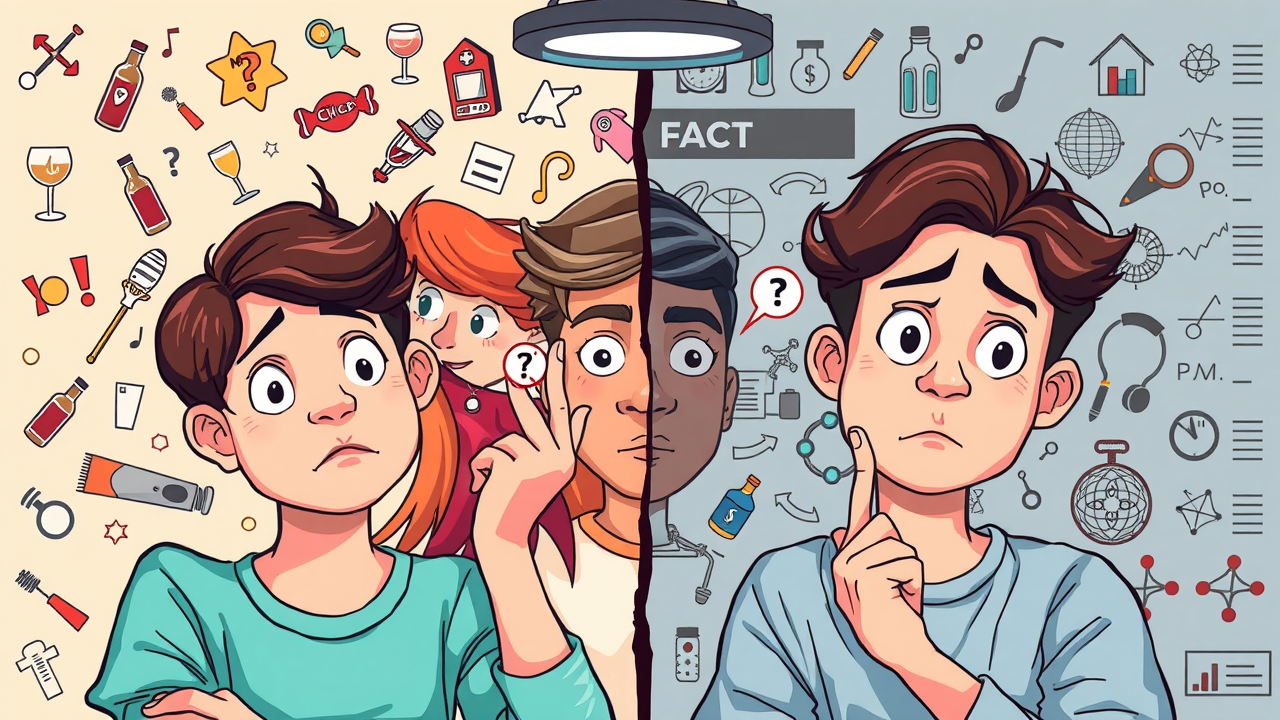Can a few drinks today secretly rob you of your full height tomorrow? Understanding how alcohol might affect your growth is crucial, especially for teens. Are the myths true, or is science telling us something different? Let’s uncover the facts about alcohol and growth.
"The idea of a 'secret' robbery of height is an apt one. The damage isn't always overt; it's a gradual process. Alcohol can impact the pituitary gland's function, which is responsible for producing human growth hormone. A less-than-optimal supply of this hormone during critical growth spurts can mean the difference of an inch or two in final height. It's a risk that many young people don't realize they're taking." - Dr. David Chen, Adolescent Medicine Specialist

Can Alcohol Today Rob You of Your Height Tomorrow? Myths vs. Facts
The question does alcohol stunt growth is one that worries both young adults and their families. It’s a question that lingers in late-night conversations, health classes, and online forums, often spawning myths that spread faster than reliable information. For teens and young people in a critical stage of physical development, distinguishing between fact and fiction is vital. While friends or social media may warn that drinking during adolescence can shave inches from your future height, what does the science actually say?
In reality, the relationship between underage drinking and physical growth is complex. Some believe that a single party night can irreversibly damage a teen's development, while others dismiss any risk, pointing to adults who drank as teens with no apparent consequences. To get to the truth, we must separate outdated stories from actual scientific evidence.
This guide will breakdown the science behind does alcohol stunt growth, reveal what major health organizations report, and empower you—whether you’re a young adult, concerned parent, or curious educator—to make informed choices about drinking alcohol during growth years.
Overview: Does Alcohol Stunt Growth in Young Adults and Teens?
Key questions: Does alcohol stunt growth, and if so, how?
Public perceptions vs. scientific evidence: Separating myth from medical reality about alcohol and adolescent growth.
Defining physical growth in adolescence: Height, bone development, and hormonal factors at play during teen years.
The main driver behind the debate on whether drinking alcohol affects physical growth is the rapid change young people undergo during their teenage years. Adolescence marks a crucial window for height gains, bone strength, muscle mass, and hormonal balance. Popular stories often suggest that alcohol exposure during this period can lead to stunted growth or other permanent health issues.
But while it's easy to find alarming headlines or anecdotes, science requires looking deeper. Medical researchers define physical growth as not only height but also the full process of body and brain development, which involves complex interactions between genetics, hormones, nutrition, and lifestyle choices—including drinking alcohol.
According to public health agencies like the National Institute on Alcohol Abuse and Alcoholism and the Centers for Disease Control and Prevention, it is crucial to examine both short-term and long-term effects of underage drinking, especially since a teen’s body is more vulnerable than that of an adult. This foundation sets up our deep dive into exactly how alcohol interact with the processes that drive adolescent growth.
What Happens to Physical Growth During Adolescence?

Biological Processes of Growth in Teens and Young Adults
During adolescence, the human body experiences a rapid and remarkable transformation—bones lengthen, muscle mass expands, and the brain undergoes critical maturation. This developmental stage, typically between the ages of 11 and 19, is orchestrated by a surge in hormones like growth hormone, estrogen, and testosterone. These hormones interact with growth plates—specialized cartilage zones near the ends of long bones—enabling teens to reach their genetic height potential.
For young people, optimal growth requires not just good nutrition and sleep, but also an environment free from toxins or behaviors that could disrupt natural processes. Studies from gov websites and medical journals stress that growth is not simply about vertical height—it’s intimately tied to healthy organ development, mental health, and future adult wellbeing.
"Alcohol consumption, even in small amounts, can disrupt the hormonal balance necessary for proper bone development, potentially leading to a final adult height that is less than what could have been achieved." - Dr. Michael O'Neill, Pediatric Endocrinologist
Factors such as genetics, regular exercise, and avoiding substances like tobacco or heavy alcohol use can play a critical role in whether teenagers achieve their full growth potential. Understanding these dynamics is necessary to appreciate how external influences, like alcohol exposure, may throw a wrench in the body’s finely tuned machinery.
It's also important to recognize that the effects of alcohol on adolescent development can extend beyond physical growth, influencing mental health and behavior. For a closer look at how urgent behavioral health support can make a difference for young people facing these challenges, explore the role of behavioral health urgent care services and their impact on youth well-being.
Critical Stages of Height and Bone Development
Physical growth is not a steady climb; instead, it follows distinct stages with key milestones. Most teens experience a major growth spurt—the maximum rate of height increase occurs during puberty, sometimes in just a couple of years. At this time, bones stretch at a record pace, and the body demands extra nutrients and hormonal support. It’s when the risk for stunted growth is greatest if something interferes with this progression.
The closing of growth plates (epiphyseal fusion) typically marks the end of a person’s vertical growth. Medical researchers note that growth plates remain open and responsive to growth hormone for a definitive period, and environmental factors during this sensitive phase—including the use of heavy alcohol—can theoretically slow or halt height progression. Young adults who make it through this period without disruptive exposures usually reach their genetic height potential, whereas any negative impact during these years, even if subtle, can have lasting consequences.
How Might Alcohol Affect Physical Growth?
The Science: Can Heavy Alcohol Use Lead to Stunted Growth?
Research findings: Sound studies on does alcohol stunt growth in adolescents.
Short- and long-term effects: Alcohol's impact on both immediate and future growth and development.
Multiple scientific studies support the hypothesis that heavy alcohol use can have a negative impact on adolescent development. As adolescents are at a crucial developmental stage, alcohol exposure may disrupt the natural patterns of growth hormone production, delay bone maturation, and interfere with the normal closure of growth plates.
Animal and human research, cited by resources such as the National Institute on Alcohol Abuse and Alcoholism, indicate that consistent, heavy drinking during adolescence can reduce levels of growth and sex hormones. This can, in some cases, contribute to slower growth or less than expected increases in height.
However, not all alcohol exposure is equally damaging. Occasional moderate drinking in late adolescence may pose less risk, but regular binge drinking or early chronic use increases the risk for long-lasting effects—not just on height, but also on muscle, bone density, and brain cell development. Clearly, the negative impact is not just a myth but is supported by credible scientific research, especially for young adults still in their growth years.

Does Underage Drinking Impact Growth Differently?
When considering does alcohol stunt growth, the question of age matters greatly. Underage drinking—consuming alcohol before the legal adult age—exposes the body to toxins during its most sensitive periods. Teens are still establishing hormonal balance, bone structure, and dense brain connections. Studies from the gov website and leading pediatricians reveal that early, repeated encounters with alcohol can hinder both height and overall maturation, making the risk of stunted growth significantly greater for underage individuals than for young adults who have already completed puberty.
According to the National Institute on Alcohol Abuse and Alcoholism, underage drinking is associated with not just risks to physical growth, but a host of other negative outcomes, like impaired brain development, mental health challenges, and increased likelihood of alcohol use disorder later in life.
Since the body has not completed its necessary growth plate closure, any interference—including drinking alcohol—can have disproportionately large effects. The take-home message: while older adults may metabolize and recover from alcohol’s effects more efficiently, teens and young adults face much higher risks from underage drinking.
Why Teens and Young Adults Are Especially At-Risk
The reason teens and young adults are especially at risk from alcohol exposure is not only due to their still-developing bodies but also their still-maturing decision-making abilities. Brain development in the prefrontal cortex—the region essential for impulse control, planning, and evaluating consequences—extends well into the mid-20s. Introducing alcohol abuse during this time magnifies the vulnerability of both brain cells and physical growth.
Elevated risks include disordered hormonal signals, impaired absorption of bone-building nutrients, and more frequent high-risk behaviors. The negative impact can extend far beyond a single night out, especially for those engaging in heavy alcohol use or binge drinking. Thus, the advice from medical professionals and united states government health experts is clear: delaying alcohol exposure as long as possible is the safest bet for protecting both height and lifelong wellbeing for young adults and teens.
Comparing Underage Drinking to Moderate Adult Consumption
When comparing underage drinking with moderate adult consumption, the primary difference is the developmental stage of the person involved. By young adulthood, after the growth plates are closed and puberty is completed, the risk of alcohol stunting physical growth is much lower. The body is more resilient, hormone cycles have stabilized, and the critical windows for height increase have generally passed.
Still, abuse—including drinking alcohol heavily or consistently—poses risks to bone health, organ function, and mental health at any age. For teens, however, the same behaviors can profoundly alter the natural progress of development. That’s why age-appropriate education and prevention efforts focus on limiting underage drinking, with a special warning for young adults who have not yet reached their full height or bone maturity.
What Are the Effects of Alcohol on Hormones and Physical Development?

Hormonal Disruption and Growth Plates
Growth plates—areas of rapidly dividing cartilage at the ends of long bones—are sensitive to hormonal signals, especially those involving growth hormone, estrogen, and testosterone. Alcohol can disrupt the delicate balance of these hormones, slowing the production of growth hormone and interfering with the endocrine system’s ability to time the closure of growth plates. Medical evidence indicates that this hormonal disruption caused by alcohol exposure is a primary pathway for its impact on physical growth.
Chronic exposure to alcohol can also cause changes in brain chemistry that further reduce hormone secretion. According to the National Institute of Child Health and Human Development, this can result not only in reduced height, but in fragile bones and decreased muscle mass as well. If disruption occurs before growth plates close, it may lead to stunted growth and a failure to reach genetic height potential, whereas after this process, the consequences are less pronounced but can still affect physical and mental health.
Risk of Growth Restriction From Alcohol Exposure
Beyond hormonal disruptions, there is the issue of direct toxicity. Heavy alcohol use in adolescence has been shown to impede the body’s absorption of vital nutrients like calcium and vitamin D, both crucial for bone development. This added risk of growth restriction is heightened for young people who combine poor nutrition with frequent drinking. Medical research highlights that not only height can be affected—organ growth, brain development, and immune function may also be compromised.
Recent studies, such as those summarized by the National Institute on Alcohol Abuse and Alcoholism, suggest that the more severe and frequent the alcohol intake, the higher the risk of lasting growth issues. The body of a growing adolescent is far less equipped to recover from or compensate for this toxin compared to that of an adult, making the negative impact on physical growth and development particularly worrisome for those engaging in underage drinking.
Scientific Studies: The Real Evidence Behind Does Alcohol Stunt Growth
Study |
Population |
Key Findings |
Level of Risk |
|---|---|---|---|
National Institute on Alcohol Abuse and Alcoholism (NIAAA) Studies |
Teens (13–19) |
Chronic alcohol use linked to lower growth hormone, delayed bone maturation, and lower adult height. |
High in heavy users |
CDC Youth Risk Behavior Surveillance |
High School Students |
Frequent binge drinking correlated with increased risk of stunted physical and mental development. |
Moderate to high |
Animal Model Research (Journal of Adolescent Health, 2020) |
Laboratory animals, adolescence |
Alcohol exposure during growth spurts reduces bone length and density; changes partially reversible with abstinence. |
Strong evidence |
WHO: Alcohol and Adolescent Health Report |
International teens, ages 10–18 |
Regular teenage drinking increases risk of lasting growth and developmental deficits, especially in malnourished populations. |
Variable, context-dependent |
As shown, the strongest risks are found among chronic, heavy adolescent drinkers, with less pronounced effects seen with occasional, moderate use in older teens and adults. Notably, most studies converge on the fact that the developmental stage at time of exposure is a key predictor of potential height loss or stunted growth.
Exploring Myths: Common Misconceptions About Alcohol and Stunting Growth
-
Most persistent myths:
“One drink will stop you from growing.”
“All underage drinkers lose height permanently.”
“Adult drinkers don’t face any risk.”
-
Fact-checking top misconceptions:
The risk of stunted growth is highest for frequent, heavy, or binge drinkers during active growth periods—not for occasional, moderate use, especially after puberty.
Only sustained disruptions to hormonal cycles or severe alcohol abuse create permanent loss in height or physical function.
Underage drinking has additional risks, including damage to developing brain cells—not just bones and height.

While myths about does alcohol stunt growth persist in pop culture and peer groups, scientific evidence gives us a more nuanced—but still critical—picture. The greatest danger lies with chronic, early, or binge alcohol exposure, especially when combined with other negative health behaviors.
Case Studies: Heavy Alcohol Consumption and Reported Growth Issues
"Real-life experiences: young adults discuss how underage drinking affected their health and physical development"
Case 1: Jake, a 23-year-old, began drinking heavily at 15 through parties and unsupervised gatherings. Now in college, Jake recounts signs of stunted growth: “I was always one of the shortest on my basketball team, even though my parents are tall. Looking back, I feel my early drinking set me back—not only in height but fatigue and slow recovery after workouts.”
Case 2: Maria, diagnosed with low bone density at 19, started binge drinking at age 16. Her pediatrician warned her that bone strength peaks during the late teens and that alcohol abuse likely contributed to her early weakness and recurring ankle injuries.

These cases echo findings from public health reports that underage drinking, especially when combined with poor nutrition or heavy use, can lead to reduced height, weaker bones, and increased susceptibility to illness—all signs of disrupted adolescent growth.
Psychological, Social and Academic Effects of Underage Drinking
Long-term Impact Beyond Physical Growth
Mental health effects: Heightened risk of depression, anxiety, and long-term substance abuse.
Academic performance: Lower grades, decreased motivation, and higher dropout risk among underage heavy drinkers.
Social relationships: Increased conflicts at home and with peers, higher risk of risky behaviors.
The effects of alcohol in teens don’t stop at the physical. Numerous studies by the Centers for Disease Control and Prevention have shown that early heavy drinking is associated with increased mental health problems and social isolation. Teens who drink heavily report higher rates of depression, poor self-esteem, and lower academic achievement than peers. On the social front, alcohol abuse can disrupt friendships, lead to risky choices, and contribute to long-term alcohol use disorders that persist into adulthood.
These holistic effects demonstrate why it’s so critical for parents, educators, and health professionals to address the risks of underage drinking not just as a physical concern, but as a multifaceted issue touching nearly every area of a young adult’s life.

Best Practices: Preventing Alcohol-Related Growth Issues
-
For teens and young adults:
Delay alcohol exposure as long as possible—especially before full puberty is complete.
Prioritize nutrition, rest, and positive social activities to support overall developmental health.
Seek help if you or friends show signs of heavy drink or alcohol dependence.
-
Advice for parents:
Start conversations about alcohol early, focusing on facts—not fear or punishment.
Model healthy habits and help kids build confidence to say no to peer pressure.
Be alert for signs of alcohol abuse, such as mood changes, declining grades, or new friends.
Prevention is most effective when families, schools, and communities offer honest, accessible information and support systems tailored for young adults. With the right guidance, teens are empowered to make choices that protect their growth and prepare them for lifelong health.

People Also Ask: Does Alcohol Stunt Growth Height?
Answer: Exploring available evidence on does alcohol stunt growth height and its biological plausibility
Medical evidence shows that alcohol can stunt growth height when exposure is frequent, heavy, and occurs before the body’s major growth plates have closed. Chronic underage drinking disrupts the production of growth hormone and other essential regulators of bone lengthening, making some growth restriction possible. For occasional, moderate drinkers who’ve already passed through puberty, the effects on final height are generally minimal.
People Also Ask: Does Alcohol Decrease Growth?
Answer: The relationship between alcohol, growth rates, and potential long-term outcomes
Yes, alcohol can decrease growth if consumed heavily during adolescence, resulting in slower growth rates and, in some cases, lifelong reductions in bone density and overall stature. The strongest effects are found in those who start drinking early, persistently, and in large amounts.
People Also Ask: What Happens If a 16-Year-Old Drinks Alcohol?
Answer: Specific risks and developmental challenges for teens consuming alcohol
A 16-year-old who drinks alcohol increases their risk for stunted growth, hormone imbalances, impaired brain development, mental health issues, social conflicts, and academic problems. Even occasional drinking can expose teens to peer pressure and elevate the likelihood of making risky choices, with the greatest danger found in heavy, regular use.
People Also Ask: Can Alcohol Cause Growth Restriction?
Answer: Growth restriction risks from chronic and binge alcohol intake in adolescents
Yes, chronic or binge drinking during adolescence can cause growth restriction, particularly if it disrupts bone formation and hormone cycles before growth is complete. The risk is heightened by poor diet, co-occurring health challenges, and early start age.
FAQs: Everything You Need to Know About Does Alcohol Stunt Growth
Is it safe for teens to drink socially?
While social drinking is common among some teens, it’s unsafe due to heightened risks for growth and brain development. Early drinking sets the stage for greater difficulties—best to wait until adulthood.How much alcohol is enough to impact growth?
Even small amounts can disrupt development if frequent or at a critical stage of growth. Binge or chronic patterns carry far greater risks than isolated use.Are there permanent impacts from occasional drinking?
Occasionally, moderate drinking in late adolescence may not have lasting effects on height, but repeated use increases risks for both stunted growth and other health problems.Can stunted growth be reversed?
If intervention happens early and alcohol use stops, some effects can improve, but permanent losses are possible if growth plates have already closed.
Conclusion: Does Alcohol Stunt Growth—What Science Really Says
"The science on does alcohol stunt growth is complex, but critical for young adults, teens, and parents to understand."
The evidence is clear: while not every drink leads to lost inches, chronic underage or heavy alcohol use can stunt growth—and the risks go far beyond height. Staying informed and delaying alcohol exposure is the best prescription for a full, healthy adulthood.
If you’re interested in taking a more holistic approach to adolescent health and long-term wellness, consider exploring broader lifestyle strategies that support growth, mental health, and resilience. The NC Wellness Hub offers a wealth of resources on nutrition, stress management, and healthy habits for all ages. By expanding your understanding of wellness beyond just the risks of alcohol, you can empower yourself or your family to make informed choices that foster lifelong vitality and well-being.
Sources
Research indicates that alcohol consumption during adolescence can negatively impact physical development. The article “Alcohol and Puberty: Mechanisms of Delayed Development” discusses how early alcohol use can delay pubertal development by affecting neuroendocrine systems in the brain responsible for initiating puberty. (arcr.niaaa.nih.gov)
Additionally, the study “Heavy alcohol use stunts adolescent, young adult brain growth” reveals that substantial alcohol consumption during these formative years can slow brain growth, potentially limiting lifelong learning abilities. (news.ohsu.edu) For a comprehensive understanding of how alcohol affects adolescent growth and development, these resources provide valuable insights.
 Add Row
Add Row  Add
Add 




Write A Comment